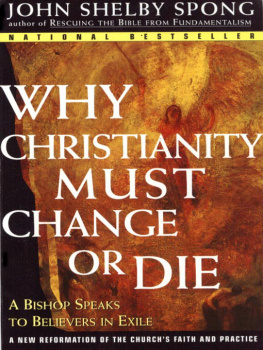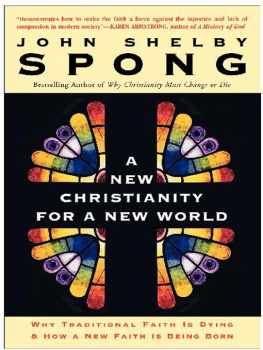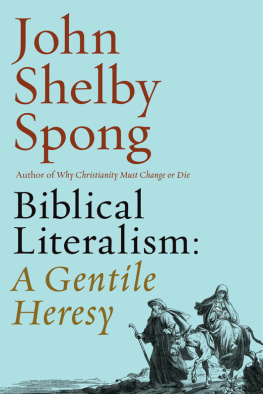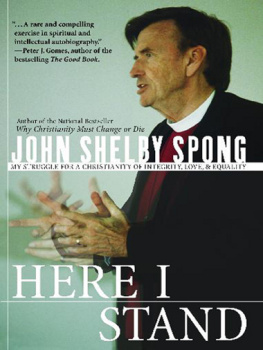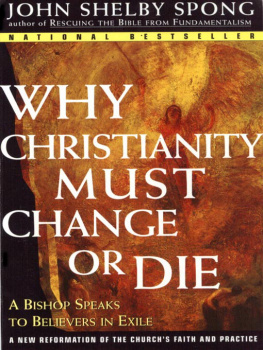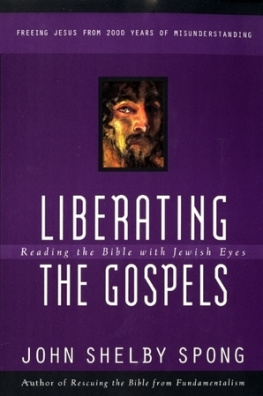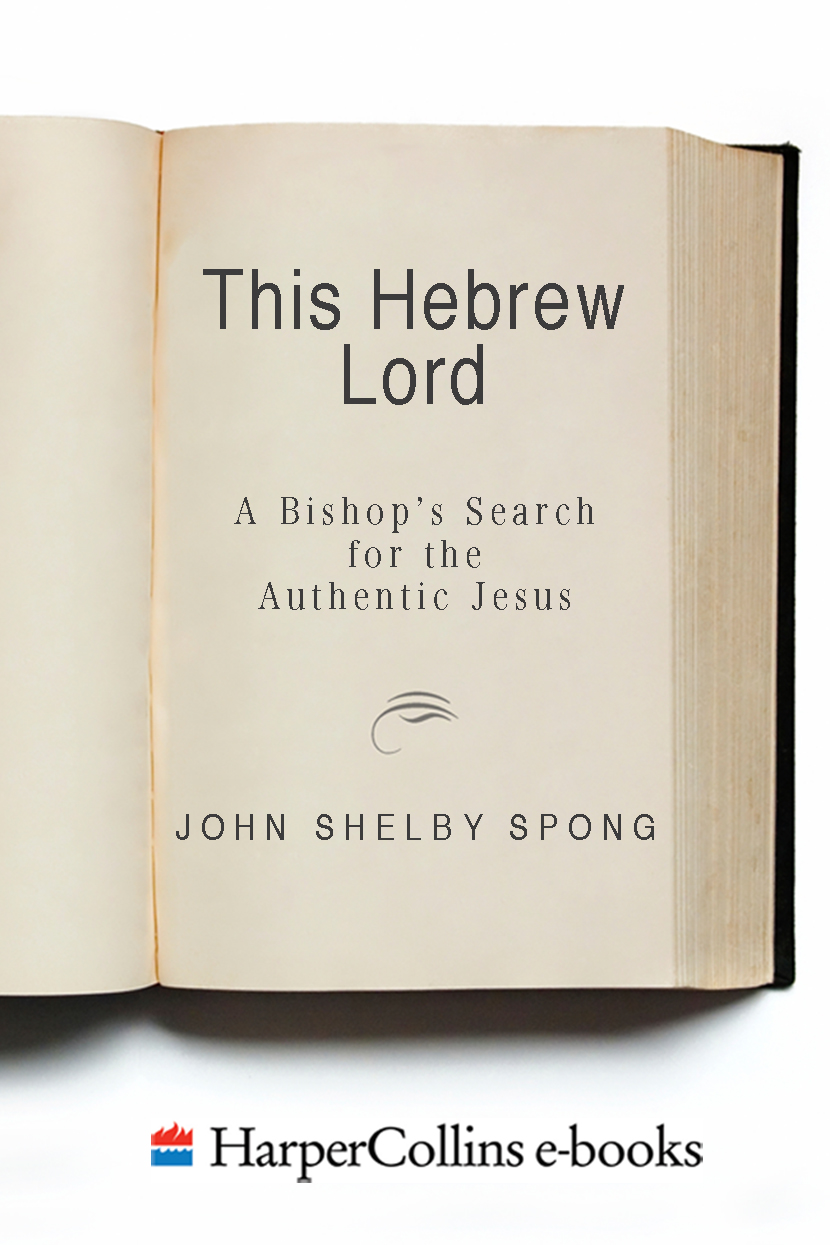Honest Prayer
Dialogue in Search of Jewish-Christian
Understanding
with Rabbi Jack Daniel Spiro
Christpower
Life Approaches Death:
A Dialogue on Medical Ethics
with Dr. Daniel Gregory
The Living Commandments
The Easter Moment
Into the Whirlwind: The Future of the Church
Beyond Moralism
with the Venerable Denise G. Haines
Survival and Consciousness
An Interdisciplinary Inquiry into the
Possibility of Life Beyond Biological Death
(Editor)
Living in Sin?
A Bishop Rethinks Human Sexuality
Rescuing the Bible from Fundamentalism:
A Bishop Rethinks the Meaning of Scripture
Born of a Woman:
A Bishop Rethinks the Birth of Jesus
In memoriam
Joan Lydia Ketner Spong
December 24, 1929August 6, 1988
For Ellen, Katharine, and Jaquelin,
special daughters, and
for John Lanier Hylton,
newest grandson.
CONTENTS
The opportunity to revise a book that has been a chronicle of the authors life is a privilege both rare and wonderful. When this book was first written it grew out of lectures that served as confirmation instruction for those who were considering joining the Episcopal church. Some of those people were shifting their religious heritage from one faith community to another. The vast majority, however, were people who had left organized religion altogether for citizenship in the secular city. They were, by and large, adults who had been raised as Christians, in rather traditional churches, with the typical religious assumptions of their day. When they entered the university world in their transition toward maturity their ancient religious assumptions no longer translated into meaning and hence they abandoned them. The God they met in church was simply not big enough to be the God for their lives. They were members of what I like to call the Church Alumni Association. That is the audience for whom I always write.
In the revised preface for the second printing of this book in 1988, I told the story of the way this book had affected my life. In many ways it established my writing career, which in time formed the study patterns of my life. One cannot write apart from the regular discipline of study. For me that time of study is the period from 6:00 A.M. to 8:00 A.M. each morning, 365 days a year. To that discipline I owe the course of my life.
This book was my second, and for many years my most popular, book. Today it is one of thirteen published volumes and has been eclipsed in sales by three others, all of which were written after the first revised edition of this volume. Those books, Living in Sin? A Bishop Rethinks Human Sexuality, Rescuing the Bible from Fundamentalism: A Bishop Rethinks the Meaning of Scripture, and Born of a Woman: A Bishop Rethinks the Birth of Jesus, catapulted me into the ranks of the top religious authors of the world. Through these works I also had my reputation for controversy enhanced. It was a reputation far more imposed on me by the press trying to understand my writings than by my writings themselves.
Lecturing on the themes of these books has taken me to every part of the United States and on expanding tours of England, Scotland, Wales, Canada, Hong Kong, China, India, Australia, and New Zealand. In many ways this present volume was the seminal volume from whence all my subsequent titles flowed.
Time has altered many things in the lifetime of this book. In the preface to the revised edition I wrote that women would be made bishops in the Anglican church before this edition sold out. I am pleased that this has in fact occurredin Massachusetts in 1989 and in New Zealand in 1990. Our church is much richer and much more whole because of that new inclusiveness.
I have updated many parts of this work, but its content remains substantially as it was written in 1973 and revised in 1988. I am pleased to discover that its themes are still powerful, provocative, and, above all, true for me. I do not mean to suggest that there have been no changes. Indeed, there were some four thousand changes in the first revision and more than two thousand in this second edition. The text has been improved, new insights added, and dated examples deleted. Subsequent study has substantially modified the present narrative. But this book was and is for me nothing less than the attempt to retell the Christ story, which is a timeless task and one that will never be complete or finished. The issue for me is whether this attempt at retelling that story has integrity. I believe that it does, so I will let it continue its life with only cosmetic revisions.
My deepest debate on the issue of revision centered on chapter 11. It was a chapter about freedom as the lens through which a modern person could perceive the divine Christ. It portrayed that freedom in the light of the enormously popular image created by Richard Bach in a bestselling book in the seventies entitled Jonathan Livingston Seagull. Many of my readers today will not recall or be familiar with that wonderful story. My conviction is that perhaps they should be, so I retold Bachs story in enough detail to capture something of his powerful account of freedom and then used that concept to open the freedom of Christ to my readers. Divinity for me is best seen in the freedom to live, the freedom to love, the freedom to be all that God created each of us to be. It is in the radical freedom of Jesus of Nazareth that I perceive God to be, in Christ, reconciling the world to God. I have chosen to let that chapter stand essentially as it was originally written.
There have been changes in my personal life also, as is inevitable with the passage of time. The original book was dedicated to my wife, Joan, and our three daughters, Ellen, Katharine, and Jaquelin. The dedication to Joan has been changed to a memorial, because she died of cancer on August 6, 1988. My daughters have brought sons into my life as their husbands in the persons of Gus Epps, Jack Catlett, and Todd Hylton, and have made me a proud grandfather to Shelby Catlett, Jay Catlett, and John Lanier Hylton. Hermann, our cat whose death I recorded in the preface to the revised edition, has been replaced by Flosshilde, Repo (for repurchased), Sam, and Axel Rodriguezour granddogs, and by Annabel, Bruiser, Nina, and Big Boyour grandcats.
Far more significant to me has been my marriage on January 1, 1990, to Christine Mary Bridger Barney, whose love and friendship touches and surrounds my life with a special grace. With Chris I was also privileged to become stepfather to Brian and Rachel Barney.
Finally, I acknowledge the gift of Wanda Corwin Hollenbeck, my executive secretary, who prepared this third preface and presided over the other changes. She has been the organizer and director of my office and career for nine years and is a wonderful professional partner and friend. How grateful I am that she is part of my life.
Shalom,
JOHN SHELBY SPONG
Newark, New Jersey
January 1993
This book is the story of a struggle that was both personal and theological. It was a struggle to translate the power of Jesus of Nazareth into the categories of our day. It is not offered as a definitive Christology but as a personal witness. It is a dialogue in which I will be revealed to my reader, and my reader will inevitably have to interact with me.
This book has been under preparation for years, as its corpus will reveal. Parts of it have been given as lectures in many churches of this land and at church conference centers at Kanuga in North Carolina and Hemlock Haven in Virginia. One chapter (11) has been substantially published as a separate article in


